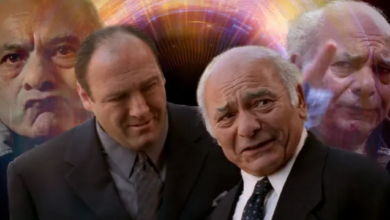Sopranos Fans Should Watch This New Mafia Series Narrated by Michael Imperioli

Michael Imperioli is back in the crime genre, but did he ever really leave? The Emmy-winning actor — better known for playing the unlucky bartender Spider in Goodfellas and the troubled DiMeo crime family capo Christopher Moltisanti in The Sopranos — is now part of another mob project. Imperioli serves as the narrator of American Godfathers: The Five Families, a three-part History Channel docuseries that traces the activities of New York’s notorious Cosa Nostra outfits across nine decades.
“Just when I thought I was out, they pull me back in!”
Like Michael Corleone, Imperioli has never quite managed to break free from the world of organized crime. Years after his character was killed off in The Sopranos, he was hired as the narrator of the show’s prequel movie, The Many Saints of Newark. Besides that, he has had plenty of fun co-hosting the podcast, Talking Sopranos, with former co-star Steve Schirripa.
Now tasked with exploring real-world mob-controlled territories, Imperioli and fellow members of the production team do a perfect job. They deliver the tea on how a golden age of organized crime came and went in one wildly productive century before everything almost came to a deafening halt with the advent of new law enforcement techniques.
American Godfathers: The Five Families Covers Oft-Ignored Mafia Topics

American Godfathers: The Five Families is catnip for crime genre fans, and it stands out by providing plenty of information that is often left out of documentaries about organized crime in America.
For example, most tales about the five families usually start at the formation of The Commission by Charles “Lucky” Luciano. The Genovese crime family boss is thus presumed to be the founding father of the New York mafia, but a lot happened before he created a ruling body. Lucky might get all the glory, but Salvatore “Little Ceasar” Maranzano is the person who brought the ‘organization’ up in the first place.
Following the bloody Castellammarese War, Maranzano noticed how disorganized Italian American gangs in New York City were, so he reorganized them into the Profaci, Maranzano, Luciano, Mangano, and Gagliano families. The families would later be known as the Colombo, Gambino, Bonanno, Genovese, and Lucchese families (names created by the FBI and not the mobsters themselves).
Maranzano would then become the capo dei capi (“boss of all the bosses”) before getting whacked less than a year later.
The docuseries also reminds audiences that the public wasn’t always familiar with the inner workings of the New York mafia. The hierarchy of the five families only became common knowledge after Genovese crime family member, Joseph Vallachi sang during the McClennan senate hearings.
Driven by disgruntlement and fear for his life, Vallachi became the first member of the Italian-American Mafia to admit that “this thing of ours truly existed.” Additionally, he was the first person to use the term ‘Cosa Nostra’ in public.
It’s also often presumed that the New York mafia died after Rudy Giuliani took the war to them in the 1980s and locked up all the bosses, including the fashion-savvy John Gotti.
American Godfathers: The Five Families proves that this wasn’t the case. The families became weaker, but they are still operational. Not much was heard about New York mobsters in the 1990s, yet Bonanno crime family boss Joe Massino was running things very effectively. Sadly, he would later become the first boss to testify and, from there on, all ‘omertà’ rules were tossed out of the window. Such information and much more, is sprinkled across the three episodes.
An Air of Meticulousness Can Be Noticed in Every Single Production Aspect

American Godfathers spoils viewers with facts and that’s a good thing. Combining exclusive photos, audio recordings, and news reports with terrifying video footage of blood-soaked post-whacking streets, the docuseries will open your eyes to the cost of adopting a life of crime.
Additionally, the docuseries draws plenty of information from the New York Times bestseller Five Families: The Rise, Decline, and Resurgence of America’s Most Powerful Mafia Empires by Selwyn Raab, who is reputed for writing some of the best investigative reports about organized crime.
The commitment to authenticity fully extends to the inclusion of various authors, law enforcement figures, and relatives of old-time mobsters as talking heads. They are all given plenty of time to say what they think, hence there are more expert anecdotes than you’ll find in an entire decade’s worth of FBI reports. Furthermore, viewers aren’t just treated to mere reminiscing of past events but also to solid commentary.
The brilliance extends to the production values. Featuring immaculate soundtracks and superb set designs, American Godfathers is one crime outing you’ll recall for a while.
Plumbing the same artistic terrain as mob documentaries like Fear City, Momo, and Mafia’s Greatest Hits, this particular project has the kind of investigative story that makes great use of tension and suspense. Viewers will enjoy how it presents New York’s extraordinary naturalistic urban beauty in counterpoint to organized crime’s cruelty.
American Godfathers Is Currently the Best Option for Genre Fans Looking to Quench Their Thirst
To crime genre fans who might be feeling starved lately, American Godfathers: The Five Families is a worthy three-episode snack. It is as much a tribute to the mobsters of the old as it is a testament to the indomitable will of law enforcement officers to cuff, prosecute, and lock up.
Studiously staying away from maudlin sentimentality and exploitative fact-finding, the series only constructs the narrative around those who are willing and qualified to talk. It’s, therefore, worth a watch in every single way.





